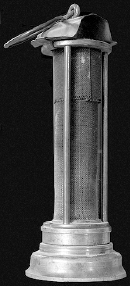070
The Brunel Museum, London, England
 51° 30′ 5.76″ N, 0° 3′ 10.8″ W
51° 30′ 5.76″ N, 0° 3′ 10.8″ W
![]()
![]()
The Thames Tunnel
In 1843, the first tunnel passing under a body of water opened beneath the Thames River, between Rotherhithe and Wapping in London. The tunnel, which is known simply as the Thames Tunnel, was built by Marc Isambard Brunel and his son Isambard Kingdom Brunel. It opened as a pedestrian tunnel featuring underground shops and entertainment, but within 30 years it had been purchased by a railway company and to this day is used to run trains.
On the Rotherhithe side, there’s a museum dedicated to the life of Isambard Kingdom Brunel and to the construction of the Thames Tunnel. Despite being the son of a Frenchman, Brunel is the most celebrated British engineer of all because he built tunnels, bridges, and steam ships that are still around today. He was also the most audacious engineer of the 19th century (and perhaps of any modern century).
His best-known achievements are the Clifton Suspension Bridge in Bristol (which opened in 1864 and was the longest bridge in the world) and the iron-hulled (and propeller-driven) SS Great Britain (see Chapter 68), but he was also the chief engineer of the Great Western Railway that linked London to western England and southern Wales. As chief engineer, Brunel supervised the construction of bridges, viaducts, and tunnels, and he also designed the London terminus of the Great Western Railway, Paddington Railway Station, which opened in 1854 and is still in use.
His last project was the steamer SS Great Eastern, which was initially intended to be a passenger ship but was the only vessel capable of carrying the enormous weight of cable needed to lay the first telegraph link between the UK and U.S. The SS Great Eastern went on to lay cables between France and Canada, and Yemen and India. When Brunel began planning the ship, he sketched an outline of a vessel much larger than any other ship afloat at the time—and the final ship was even bigger.
Today many of Brunel’s bridges and tunnels are still in use, and the British landscape is literally dotted with his handiwork. The Brunel Museum sits atop his Thames Tunnel, in a building that originally held a steam pump used to remove water from the tunnel.
The museum offers trips through the tunnel, sometimes on foot in the dead of night, and sometimes in trains that creep along while the walls are floodlit. From the train, you can clearly see the Brunels’ carefully constructed tunnel, with its columns and arches forming spaces that were once occupied by stall holders in the first underground shopping center.
Above ground, the museum has a detailed exhibition of the construction and use of the Thames Tunnel, as well as information about Brunel’s many other innovative projects.
Practical Information
The Brunel Museum’s website is at http://www.brunel-museum.org.uk/. At the time of this writing, the tunnel is closed while the train line is renovated as part of the creation of a new overland railway due to be completed in mid-2010. The museum remains open, though, and is working to restore its tunnel trips as soon as possible.
